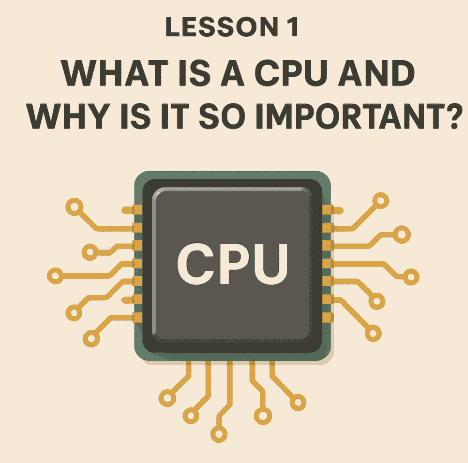
🎮 Let’s Start with a Game
Imagine you’re playing your favorite video game.
You press a button. Your character jumps.
It feels like magic. But it’s not.
Something inside your computer or tablet is working really fast to make that jump happen.
That something is called the CPU.
Let’s find out what it is.
🪙 What Is a CPU?
CPU stands for Central Processing Unit. That’s a big name, so we’ll just call it CPU.
The CPU is the thinking part of the computer. It’s the part that looks at instructions and says,
“Okay, I’ll do this next!”
It doesn’t think like a human, but it follows steps really, really fast.
If you tell the CPU,
“Add 2 + 3”
It says,
“The answer is 5.”
If you say,
“Draw a blue circle”
It says,
“Done.”
That’s the CPU’s job: do things, step by step.
🧱 What Is It Made Of?
Inside your computer, there are lots of parts. One of these parts is the CPU.
The CPU is a tiny, flat square made of metal and special materials.
This little square is called a chip.
Even though it’s small — about the size of a cookie — it holds billions of tiny switches.
Yes — billions!
Each switch is like a light that can be either on or off. We call that 1 (on) and 0 (off).
You already learned in earlier course on How Computers Work that everything in a computer is made from these 1s and 0s.
Words, pictures, music — everything!
The CPU uses these on/off switches to follow instructions.
🧠 So… Is the CPU the Brain?
Kind of — but not exactly.
It’s like the brain, because it’s the part that does all the work.
But it’s not smart like your brain.
The CPU can’t feel, dream, or make up ideas.
It only does what it’s told. Always.
But it’s super fast. It can follow billions of steps every second!
Imagine if your teacher gave you a list of 100 questions and you finished all of them in one blink.
That’s what the CPU does — again and again and again.
🛠️ What Does the CPU Do All Day?
Let’s say your computer is a big machine with many helpers.
There’s:
-
a part that remembers things for a short time (this is called RAM)
-
a part that stores things forever (this is called your storage or hard drive)
-
a part that shows pictures (your screen)
-
a part that lets you type or click (your keyboard or mouse)
The CPU is like the boss in the middle.
It tells every helper:
-
“You! Show this picture.”
-
“You! Remember this number.”
-
“You! Add these two numbers.”
-
“You! Play this sound.”
Without the CPU, nothing moves. Nothing works.
🧮 How Does It Know What to Do?
The CPU doesn’t guess. It follows instructions.
These are very tiny steps written in a special language the CPU understands — a language made of 1s and 0s.
If the instructions say:
“Add 2 and 3,”
“Then show the number on the screen,”
“Then play a sound,”
The CPU does them one at a time, very fast, in the right order.
It never skips steps.
It never gets tired.
It never says, “I don’t feel like it today.”
🧊 What Happens Inside the CPU?
Inside the CPU chip, electricity moves around.
That electricity goes through tiny switches. These switches are super small — smaller than a piece of dust!
When electricity goes through a switch, it turns on (1).
When it doesn’t, the switch is off (0).
By turning on and off really fast, these switches carry out instructions.
That’s how the CPU adds numbers, moves things on screen, and more — just by flipping switches!
🧩 A Quick Reminder From Before
Let’s remember a few words we’ve learned already:
| Word | What It Means |
|---|---|
| Bit | A single 1 or 0 |
| Byte | 8 bits together |
| RAM | Short-term memory — remembers things for now |
| Storage | Long-term memory — remembers things forever |
| Chip | A flat, tiny square inside your computer that holds billions of switches |
| CPU | The thinking chip — follows instructions and tells other parts what to do |
u open a game on your tablet.
What happens?
-
You tap the game icon.
-
The screen sends that signal to the CPU.
-
The CPU says, “Okay! Open the game.”
-
It asks the storage for the game files.
-
It sends the pictures to the screen and sound to the speakers.
-
It watches for your next move — like a jump or a click.
And it does all this super fast. You don’t even notice the wait.
🚫 Is the CPU the Only Important Part?
Nope!
The CPU is very important — but it can’t work alone.
It needs:
-
RAM to help remember things for now
-
Storage to find saved files
-
Input devices like the mouse and keyboard to hear your commands
-
Output devices like the screen and speakers to show and play things
The CPU is the main helper, but it works best when all the other parts do their jobs too.